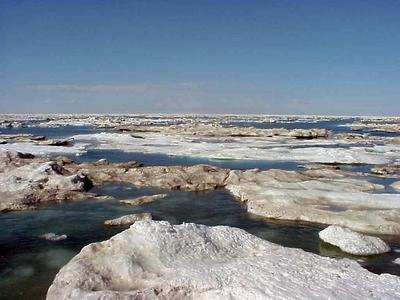
|
|
20 July, 2002
My day started with the station at midnight. Because
I need to help collect water from the service cast
right at the beginning and I am collecting mud at the
end, I was there for the entire time. Since this was
a short station, we were done by 4:30 AM. The 24 hour
daylight makes it easier to work, but it is difficult
to keep track of time and, since we do stations at odd
hours, it is even tough to remember what day it is!
Our sampling procedure was basically the same as the
previous station. If you think about it, itís easy to
see why the mud sampling is at the end of the station.
All those people taking measurements in the water
donít want it filled with our mud. One thing made
this station even more interesting; we saw ice for the
first time. In the morning, it was in large chunks
floating by in the distance. By evening the ship was
hitting ice regularly and we could feel the
vibrations.
I am so lucky to be a part of this major project
called the Shelf-Basin Initiative (for a description,
see my part of the TEA web page). Not only do I get
to work with one parcticular project, I get to see all
the other work going on around me. Itís a wonderful
opportunity for me to brush up on my science in areas
other than biology. Although each project has its own
specific goals, each one contributes to the overall
goals of the SBI project. Today Iím going to tell you
about Cindy Mooreís work.
Cindy is a chemist who works with Dennis Hansell from
the University of Miami. Each time I go out to
collect water for oxygen-18 analysis, Cindy collects
water right behind me. (Remember that there is a
specific order we have to follow so everyone gets the
water they need at the right time.) She wants to know
the balance of inorganic (from non-living sources) and
organic (from living things) nitrogen in the water.
Nitrogen is an important part of the food chain (who
eats what) and her water analysis will allow her to
understand the chemistry of the water and the
environment the animals are living in. After she
filters the water she ďburnsĒ it (oxidizes it) by
shooting the water into a 900 degree Celsius furnace
to change it to a form that her instrument can detect.
Although she has been collecting samples and working
right from the beginning, her detector is not yet
functioning. She had problems setting it up, and it
seems to stop working at the same point in each
experiment. While she continues to try to fix the
problem, she is freezing her samples to preserve in
case she needs to analyze them once she is back at the
University of Miami. If she has to do all the samples
at home, she will have to work an additional month to
get them done. Sheís really hoping to finish them
while we are on board! When you are out in the ocean,
it is tough to get spare parts or someone to repair
equipment that doesnít work!
Saturday is morale day on the Healy. The crew is on
board for long periods of time with very little time
to themselves. For example, the ship left its home
port in Seattle, Washington on April 27th, and they
wonít return to Seattle until mid October. Thatís why
things like a pudding eating contest (who could come
closest to finishing a 7 pound can of pudding in 15
minutes) and a barbeque on the helicopter deck are a
great way to break the routine for these hard working
men and women. Our evening station, the first in
Barrow Canyon, was postponed until after dinner, so we
were all able to enjoy the on deck barbeque!
Some people on board saw walruses swimming by this
morning, but I was wrapping up the work for our
station and I missed them. This afternoon, however,
someone spotted a polar bear finishing a seal meal on
a small ice flow near the ship. Needless to say it
ran off, jumped into the water, and swam away. I got
there in time to see it swim off. I was much luckier
later in the day. When a polar bear is spotted, it is
announced over the shipís intercom. We heard the
announcement that a polar bear was on the starboard
side near the bow. We all watched as the bear ran
across the ice, periodically looking over to check us
out! He/she provided entertainment for well over half
an hour.


Saturdays are morale days for the crew. Tonight we were were all treated to a barbeque on the helicopter deck.

At the midnight watch we spotted ice for the first time. By late afternoon we were surrounded by floating ice chunks, two of which held polar bears (not seen in the picture unfortunately.)

Cindy Moore is sampling water to find total nitrogen. She will use that information to better understand the chemistry of the water and the environment the animals are living in.
Contact the TEA in the field at
.
If you cannot connect through your browser, copy the
TEA's e-mail address in the "To:" line of
your favorite e-mail package.
|
